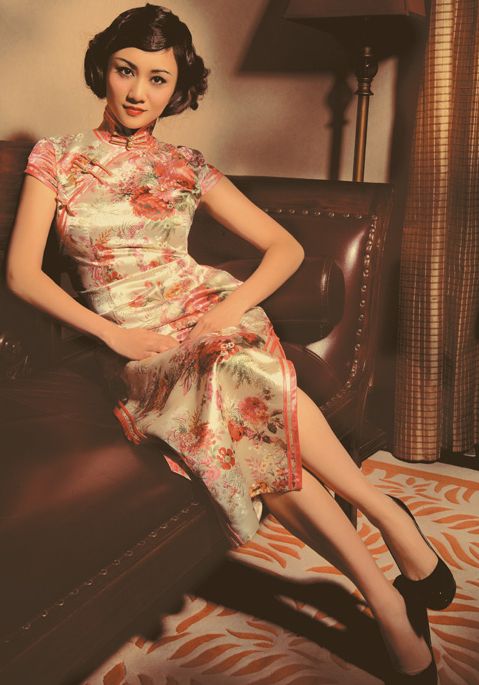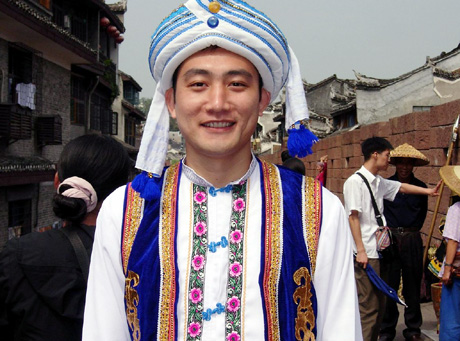Hello, lovely people! Today I interrupt the regular programming to bring you a post by me and featuring... me. Diana. Let it be clear that I am not a fan of being in front of the camera--there is a reason why I'm always behind it, after all. But Chinese New Year is coming up on the 19th of February, and even though Koreans celebrate the Korean New Year on the same day (along with several other countries, leading to the more general name "Lunar New Year"), Dorothy persuaded me to be in front of the camera for once. Thank you, Doro, for taking the pictures! For everyone asking me what I use to edit the pictures--I use Photoshop and Lightroom, but you can also find out more information regarding technical aspects of the blog on the "About" page.
Lunar New Year (Year of the Sheep)
Lunar/Chinese New Year is certainly the biggest holiday of the year in China. Growing up in China, I loved Chinese New Year not because it might bring me new beginnings and eradicate the bad luck of the past, but because it meant red envelopes full of money. The thing is, I am very frugal. I would tuck the bills into empty doll boxes and collect money until my parents forced me to spend some to buy dumpling dough. Sometimes I feel like this whole "red envelope" deal is a bit too shallow, plump with over-affection and perhaps under-deserved, but then again, who really cares? The children are excited whether it's one yuan or a thousand. It's a gesture of trust and kindness, and that is what Chinese New Year is, at its core, really about.
Another aspect of Chinese New Year that I've always loved is the food. I am constantly hungry. But it's the weird sort of hungry where my stomach tingles and my heart jingles at the thought of food, but I can't even eat one complete plate without feeling utterly full. Chinese New Year, however, is always an exception. I remember making dumplings from scratch with my grandma and my aunt, carefully plopping chopstick-fuls of filling onto dough sagging with water. We'd twist the dough, pinch it in waves, maybe clean some coins and hide one in the filling. Not the most sanitary thing for sure, but it'd make me anticipate the food even more, in ways only a child can. The chubby-hands-grabbing, puffy-eyes-begging, toddler-legs half-running half-falling after plates of unfinished dumplings sort of excited desperation.
Though ever since the early 1900s many Chinese stopped wearing traditional clothes (due to a variety of historical events that are subjects for another day), 唐装 (tangzhuang), or quite literally clothes based on the Tang Dynasty though it really just means costume, still perseveres as fundamental pieces of performance outfits. The modern 旗袍 (qipao), emerging from the absolutely stunning Flappers movement in Shanghai in the 1920s, is perhaps the most popular modern adaptation of traditional clothes. Though a collarless gown similar to the modern qipao was trendy during the Qing Dynasty (1644-1911), it's interesting to think about how ultimately a Western movement merged with traditional Chinese culture to create a new style still prevalent at formal occasions today.
Colors play a major role in traditional dresses/qipaos:
- Black is for young boys
- Blue and Green represent immortality and harmony respectively (the colors of spring)
- Gold boasts strength and wealth
- Pink is for marriage
- Purple speaks of wealth (as it used to be quite expensive to make)
- White, or the end, is used for mourning
- Yellow is imperial
- Red (by far the most popular) symbolizes good luck, happiness, joy, energy, and is prominent among brides.
 |
| source |
I play the 二胡 (erhu), a traditional Chinese instrument, as part of a traditional Chinese music orchestra. If you are in the Southern California area, you may be interested to know that my orchestra is having a concert celebrating the Lunar New Year (another name for the Chinese New Year since it's based on the lunisolar calendar) on February 28th at Mt. SAC. I can't make it due to scheduling conflicts, but I highly suggest you go. Traditional Chinese music can be very beautiful, I'd like to think. (You can listen to one of my favorite erhu pieces here.)
Here are pictures of me and my erhu:
I am wearing a qipao top, which happens to be part of my orchestra performance outfit. Surrounding me are two vases of my parents. I recall seeing these around the house since I was a wee little lass in China, so I'm not exactly sure of their origins.
The red cloth embellished with gold beadings is called a 手绢 (shoujuan). You put one finger at the center circle and twirl it, though that's only the basics. Many times, Chinese New Year celebrations feature professional shoujuan performances. Though I don't have a picture of it, another common feature is the lion dance. When I was in elementary school, I often visited my brother's preschool and helped his class choreograph the lion dance. It actually requires a lot more strength than it looks, but of course I was too stubborn to tell people that. Here is a video of a lion dance, which starts at 2:30, if you'd like to see one.
This bracelet was gifted to me by my mom's good friend. If you ever go to Tibet, please do check out their handmand jewelry. Amazing craftsmanship. That being said, the China-Tibet conflict is a topic I'd like to discuss but at another time.
This is where all my friends from orchestra are going to chastise me and I will absolutely deserve it. I played the 古筝 (guzheng), another traditional Chinese instrument, back in China, and I still remember how to play it. However, you're supposed to use fake nails while playing, and my fake nails were in a compartment of the guzheng that I couldn't get open. So just... use your imagination?
purple qipao top courtesy of my mom
This following outfit is my favorite. There are 56 ethnic groups in China, and I belong to a minority called 布依族 (Buyi). We have quite a number of traditional clothing, different for males and females. Males generally wear a torus-shaped headdress while females wear cloth hats. I couldn't find the pictures of my dad in his headdress so here is one from online:
 |
| source |
Here is a picture of my paternal grandparents:
This photograph, which is quite old, accentuates the influence of modern fashion on traditional ethnic clothing.
My messenger bag was hand-crafted by a Buyi. We are renowned for our weaving and jewelry. Well, the typical Buyi is. Me, not so much. My crafting abilities extend to repairing clothes and maybe very basic sewing techniques. The slit on the side of my skirt demonstrates quite well, I think, the juxtaposition between contemporary clothing trends and more modest traditional clothing.
Our clothes tend to be made of simple cloths. You can see the influence of upper-class dynastic Chinese fashion with the buttons and weaved-in patterns.
Both of these are close-ups of ethnic accessories. The messenger bag I've already explained. The bracelet was a gift from my father's friend. I believe it is a 苗族(miao) bracelet--the Miao, another ethnic minority belonging to the same areas of China as the Buyi, are well-known for their silver jewelry.
Miao children at a tourist attraction // 彝族 (yi) children at a tourist attraction, holding what I think is 芦笙 (lusheng), but don't quote me on that as I'm not sure why it's curving up. (Edited to add: though many lusheng do not have several pipes that curve up, some do. This is indeed a lusheng. Also, because the lusheng is a Hmong instrument, the yi children may be hmong. Not 100% sure.)
At the end of the day though, traditional clothing is certainly fading out. When I went back to China in the summer of 2013, I captured this shot of a popular spot in Hangzhou.
Even with traditional boats resting at the dock with calligraphy-dusted chambers waiting for tourists to fall in love with 西湖(xihu, or West Lake), the people have emerged into a new era of Chinese culture. It is actually this trip that inspired me to re-evaluate my heritage and begin a series of conceptual photographs based on ancient East Asian folklores. Here is 笔歌墨舞 (a Chinese idiom meaning song-plump brush, dance-drunk ink), the latest piece of my Oriental Folklores series featuring of course the lovely Dorothy:
 |
| You can view more of my Oriental Folklores series by visiting my website here |


























Hi. Both photos of the children are Miao/Hmong children, and yes that's a lusheng. US Miao lusheng and Huaxi Miao lusheng are the same; they both curve up
ReplyDeleteHi, thank you for commenting! The picture of what I wrote as "Yi" children was taken at a Yi festival, so though I realize that lusheng is a hmong instrument, I thought that they were likely to be yi. But you're right that it'd make sense for them to be hmong. Given the context, it's a bit hard to pinpoint. Perhaps they're half-Yi half-Hmong.
DeleteRegarding the lusheng, I agree with you that that's what the instrument is. But I wouldn't necessarily say that Miao lusheng all curve up. Most lusheng I've seen Miao play (in person) do not have several pipes that curve up but rather are straight. A quick google search will bring up images of lusheng with straight pipes as well. Of course, there are definitely curved lusheng, but at the time when I wrote this post, I had mainly seen straight lusheng so I wasn't 100% sure on the curvature.
Thank you for taking the time to read this post. We really appreciate it! :)
-Diana